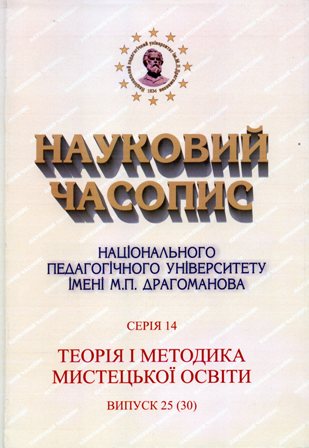The method of formation of artistic empathy of future music teachers
Keywords:
artistic empathy; modeling method of artistic and pedagogical situations; future music teacherAbstract
Relevance of the study. The article proposes a new method of forming the artistic empathy of students of art faculties of pedagogical universities. Particular importance is given to such methods and techniques of piano learning as actualization of students' artistic and emotional memory, activation of artistic and associative thinking of students, variation of musical works, induction of students to introspection of musical impressions, involvement of future teachers in comparing artistic phenomena. It emphasizes the essential role of modeling artistic and pedagogical situations, as well as the application of biographical methods for comprehension of composer style. In the scientific literature, the question of the formation of artistic empathy is considered only fragmentarily (A. Zaytzeva, O. Oleksuk, N.Popovich). The possibilities of piano teaching of students in the formation of artistic empathy are almost not studied at all. The purpose of the article is to highlight the technique of forming artistic empathy in the process of piano teaching of students of pedagogical universities. Discussion. The influence of musical art on the formation of personality is determined by its ability to comprehensively comprehend the content of a musical composition at the level of empathy, to artistic empathy. The formation of empathy is closely linked to the presence in the person of the stock of emotional impressions of musical works.The article examines methods and techniques for forming the artistic empathy of future music teachers in the process of learning piano playing.1. A block of methods and techniques for updating the artistic and emotional memory of students. This block of methods involves determining the personal inclination of students to the music of a certain mood.2. A block of methods and methods of activating the artistic and associative thinking of students is proposed. These are methods and techniques for establishing associative relationships. Such methods and techniques are based on the ability of the human psyche to memorize different images on the level of the subconscious. The processes of emotional penetration into the content of artistic images are intensified.3. The block of methods and techniques encourages students to introspection of musical impressions. This block of methods focuses on self-knowledge as a process of successive actions of self-knowledge in music. Comparison with the previous artistic experience is aimed at actualizing the musical experiences of students. 4. A block of methods and techniques for attracting future teachers to compare artistic phenomena. Reception of comparison makes sense only when distinguish those features that reproduce the internal laws of the phenomenon.5. The block of methods and techniques of variant processing of musical works is aimed at attracting students to the perception and evaluation of various interpretations of the same musical work.6. The block of biographical methods and methods of studying the composer's creativity. Outside of the awareness of personal motives of creativity it is difficult to fully perceive the artistic text of the work. Feel the intentions of composes, penetrate into the peculiarity of his personality, to realize the aesthetic credo of his work helps to familiarize himself with his biography.7. The block of methods and techniques of modeling artistic and pedagogical situations of perception of musical works. Future teachers should be prepared not only to empathize with the perception of artistic images, but also to bring musical works to disciples. Students should get acquainted with the technique of bringing the student's emotional state to the perception of musical works.
References
Bochkarev, L. L. (1997), Psikhologiya muzykalnoy deyatelnosti [Psychology of musical activity]. Institut psikhologii RAN, Moscow. [in Russian]
Ziaziun, I. A. (2003), Bezsvidome i tvorcha intuitsiia [Nonconscious and creative intuition]. Professional Education: Pedagogy and Psychology. Ukrainian-Polish Journal. Ed. by I. A. Ziaziun, T. Levovytsky, N. Nychkalo, I. Vilsh. Czestochowa-Kyiv. Vol. 4. pp. 121-137. [in Ukrainian]
Ekman, P. (2015), Psykholohyia emotsyi [Emotions Revealed: Recognizing Faces and Feelings to Improve Communication and Emotional Life]. Translated from English by V. Kuzin. [in Russian].
Oleksiuk, O. M. (2006). Muzychna pedahohika: navchalnyi posibnyk [Music pedagogy]. – Kyiv: KNUKiM. [in Ukrainian].
Popovych, N.M. (2012). Muzychna pedahohika: navchalno-metodychnyi kompleks [Music Pedagogy: Educational and Methodical Complex]. Mukachevo: MDU. [in Ukrainian].
Bailey, Derek (1980). Improvisation: Its Nature and Practice in Music. England: Moorland Pub.
Madenfort, W. (1972). Aesthetic Education: An Education for the Immediacy of Sensuous Experience. Art Education, 25(5), pp. 10-14. doi:10.2307/3191688.

